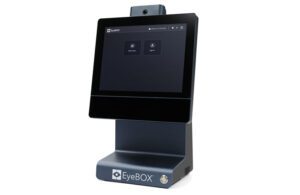
Oculogica CEO Rosina Samadani [Photo courtesy of Oculogica]
Less than three months after Oculogica won FDA clearance for its portable concussion diagnostic device, contract manufacturer Minnetronix is about to ship the first units to customers.
“We are aspiring to be a vital sign for brain health,” Oculogica CEO Rosina Samadani said in an interview.
Diagnosing a concussion used to require asking a patient if they have a headache, fatigue, or nausea along with a host of subjective questions about how they feel in a 15- to 25-minute exchange.
The Oculogica EyeBOX test takes four minutes, measuring eye movement with a near-infrared camera that records gaze positions 500 times per second as a patient watches a video, then using an algorithm to calculate a BOX score. A score below 10 means no concussion, while 10 or higher indicates the patient is concussed. The test doesn’t require any pre-concussion baseline or accurate answers from a patient who might have trouble communicating or an athlete motivated to get back on the field.

The portable Oculogica EyeBOX EBX-4 [Photo courtesy of Oculogica]
Samadani credited St. Paul, Minnesota-based Minnetronix for a fast launch following the latest regulatory approval despite design changes and supply chain challenges.
New Richmond, Wisconsin-based Oculogica secured FDA 510(k) clearance for the new EyeBOX Model EBX-4 as a Class II device in December 2021.
The original EyeBOX won FDA De Novo classification in 2018. The FDA cleared the next two versions — adding Wi-Fi, swapping its wheeled chassis for a table-top enclosure and other modifications — through the 510(k) pathway in 2019 and 2020.
The new EyeBOX EBX-4 brings the most changes, starting with a weight drop from 34 pounds to just under 12 pounds and a reduction in volume from 6.3 cubic feet to 1.05 cubic feet. The next-generation EyeBOX also adds a second camera and a rechargeable battery for power on the go.
The older, bulkier version is used by health care organizations such as the Minneapolis Clinic of Neurology and Chicago-based Midwest Orthopaedics at Rush. Both are interested in the portable version that can more easily move from room to room — or different sites, Samadani said.
Minnetronix helped Oculogica transfer the design from a research and development phase to manufacturing, optimizing the device from a supply chain perspective. More often than they’d like, even manufacturers like Minnetronix have products ready to go except for one or two components that are suddenly in short supply, said Matt Adams, VP and GM of Minnetronix’s neuro, optics and fluids technology segments. The situation can delay manufacturing and end-of-line test development for months at a time.
“It’s a relentless pursuit of not only the core vendors you’re working with, but the brokers that are often coming in and buying out from underneath longtime customers,” Adams said. “Your negotiating skills have got to be razor-sharp.”
Minnetronix recently announced an optical medical device development partnership with INO Innovation Center, but Adams said that deal was too new to be part of the Oculogica project.
“We went to Minnetronix because they have specialized skills in ocular engineering,” Samadani said. “We were really interested in that because we use eye-tracking … we’re looking at a lot of different things: how quickly they move, how well they move together, those types of things.”

Oculogica founder Dr. Uzma Samadani [Photo courtesy of Oculogica]
So what does the BOX in EyeBOX stand for? It’s shorthand for “brain-injury-associated ocular motility dysfunction,” a phrase coined by Samadani’s neurosurgeon sister, Dr. Uzma Samadani, who runs the University of Minnesota’s Neurotrauma Research Lab and founded Oculogica in 2013.
One of the most significant advances in concussion testing developed by Dr. Samadani is that the EyeBOX does not need pre-test calibration, which would require the device to have a look at a patient’s eyes before they sustain a traumatic brain injury for comparison.
“It’s called non-spatial calibration,” Rosina Samadani said. “We’re the only ones that have that.”
Rosina Samadani wants Oculogica to expand to other areas of brain health, including elevated intracranial pressure, cognitive decline and traumatic encephalopathy syndrome (TES). TES is the clinical disorder associated with chronic traumatic encephalopathy (CTE), which can only be diagnosed with a post-mortem exam of brain tissue.
“We’re very satisfied with where we are now, and we’d like to get it out to more people for concussion, [but] other areas of brain health … are in our future,” the Oculogica CEO said.